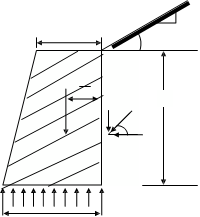Find the maximum and minimum pressure:
A masonry retaining wall of trapezoidal section and earth side face vertical has a top width of 1.5 m and base width of 3.5 m. The wall is 6 m high and retains earth at a slope of 1 vertical to 2 horizontal. The weight of soil retained is 18 kN/m3 and the angle of repose is 30o. Find the maximum and minimum pressure intensities at the base of the wall. Weight of masonry is 23 kN/m3.

(a) Retaining Wall

(b) Pressure Diagram
Figure
Solution
Considering 1 m width of wall (Figure 12).
tan α = 1/2
∴ α = 26.57o and cos α = 0.8944
φ = 30o ∴ cos φ = 0.866
∴ Coefficient of active earth pressure
= 0.5366
∴ P = Ka = Wh2/2 = 0.5366 × 18 ×62/2= 173.87 kN
which is inclined at an angle α = 26.57o with horizontal.
Horizontal component of P, Ph = P cos α = 173.87 cos 26.57o = 155.5 kN
Vertical component of P; Pv = P sin α = 173.87 sin 26.57o =77.7 kN
and P acts at a distance h/3 = 6/3 = 2 m above the base.
Weight of masonry wall (per m width),
W = (a + b)/2 ⋅ h ⋅ ρ = (1.5 + 3.5)/2 × 6 × 23 = 345 kN
This acts at a distance of x¯ from C,
Where x¯ = a2 + ab + b2/3(a + b) = 1.317 m
∴ Total pressure acting on point C of that the base will be
Pc= (W/b)+(Pv/b)+ (6W(b/2- x¯)/b2)+(6Pv(b/2)/b2 )- (2Ph× h/b2)
= (345/3.5) + (77.7/3.5) +( 6 × 345(1.75 - 1.317)/(3.5)2 )+ (6 × 77.7 × 1.75/(3.5)2 )- (2 × 155.5 × 6/(3.5)2)
= 108.21 kN/m2
Or total pressure acting at point D of the base will be
PD= (W/b)+(Pv/b)+ (6W(b/2- x¯)/b2)+(6Pv(b/2)/b2 )- (2Ph.h× /b2)